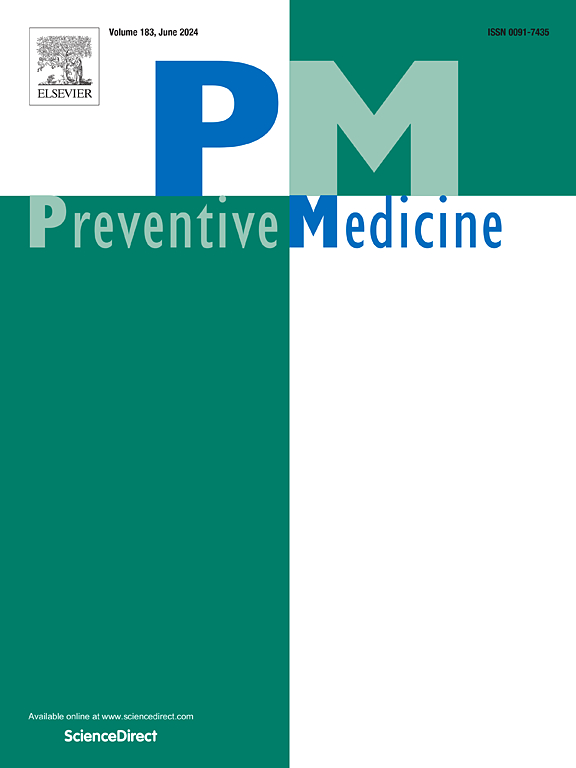The heterogeneity of youth at risk of prediabetes and diabetes: A latent class analysis of a United States national sample
IF 3.2
2区 医学
Q1 MEDICINE, GENERAL & INTERNAL
引用次数: 0
Abstract
Objective
Prediabetes and diabetes are complex conditions associated with interrelated factors from multiple domains, including lifestyle, health, and sociodemographic status. We aimed to identify youth subgroups with co-occurring features from these domains to inform prevention and intervention efforts.
Methods
We analyzed data from 1278 adolescents (ages 12–17 years) from the 2011–2018 United States National Health and Nutrition Examination Surveys. Prediabetes/diabetes was defined using hemoglobin A1c (≥5.7 mg/dL) and/or fasting plasma glucose (≥100 mg/dL). We applied latent class analysis of physical activity, diet quality, screen time, and body mass index (BMI) identified subgroups adjusting for sociodemographic factors. Associations between latent class membership and prediabetes/diabetes were assessed using survey-weighted logistic regression.
Results
Four classes emerged: High BMI and unhealthy lifestyle (37.5 %), Healthy BMI and physically active (24.7 %), Healthy BMI and lifestyle (16.0 %), and Average BMI and lifestyle (21.8 %). Compared to youth in the High BMI and unhealthy lifestyle class, youth in the other three classes all had lower odds of prediabetes/diabetes, where the adjusted odds ratio was 0.56 (95 % CI: 0.33–0.95) for youth of the Healthy BMI and active class, 0.46 (95 % CI: 0.21–1.01) for youth in the Healthy BMI and lifestyle class, and 0.68 (95 % CI: 0.42–1.10) for youth in the Average BMI and lifestyle class.
Conclusions
The latent class analysis revealed four youth subgroups with different lifestyle, health, and sociodemographic characteristics, and youth prediabetes/diabetes status was associated with the latent class membership. The results suggest potential heterogeneous interventions over one-size-fits-all approaches to mitigate prediabetes/diabetes risk among youth.
青少年糖尿病前期和糖尿病风险的异质性:美国国家样本的潜在分类分析。
目的:前驱糖尿病和糖尿病是一种复杂的疾病,与生活方式、健康状况和社会人口状况等多个领域的相互关联因素有关。我们的目的是确定具有这些领域共同发生特征的青年亚群体,为预防和干预工作提供信息。方法:我们分析了2011-2018年美国国家健康与营养检查调查中1278名青少年(12-17 岁)的数据。糖尿病前期/糖尿病的定义是血红蛋白A1c(≥5.7 mg/dL)和/或空腹血糖(≥100 mg/dL)。我们对身体活动、饮食质量、屏幕时间和身体质量指数(BMI)进行了潜在分类分析,确定了经社会人口因素调整后的亚组。使用调查加权逻辑回归评估潜在类别成员与前驱糖尿病/糖尿病之间的关联。结果分为高BMI与不健康生活方式(37.5% %)、健康BMI与运动(25.3% %)、健康BMI与生活方式(16.0% %)和平均BMI与生活方式(21.8% %)4类。与高BMI和不健康生活方式组的年轻人相比,其他三个组的年轻人患前驱糖尿病/糖尿病的几率都较低,其中健康BMI和活跃组的校正比值比为0.56(95 % CI: 0.33-0.95),健康BMI和生活方式组的校正比值比为0.46(95 % CI: 0.21-1.01),平均BMI和生活方式组的校正比值比为0.68(95 % CI: 0.42-1.10)。结论:潜在阶级分析揭示了四个具有不同生活方式、健康和社会人口学特征的青年亚组,青年糖尿病前期/糖尿病状态与潜在阶级成员相关。结果表明,在一刀切的方法中,潜在的异质性干预措施可以减轻青少年糖尿病前期/糖尿病风险。
本文章由计算机程序翻译,如有差异,请以英文原文为准。
求助全文
约1分钟内获得全文
求助全文
来源期刊

Preventive medicine
医学-公共卫生、环境卫生与职业卫生
CiteScore
7.70
自引率
3.90%
发文量
0
审稿时长
42 days
期刊介绍:
Founded in 1972 by Ernst Wynder, Preventive Medicine is an international scholarly journal that provides prompt publication of original articles on the science and practice of disease prevention, health promotion, and public health policymaking. Preventive Medicine aims to reward innovation. It will favor insightful observational studies, thoughtful explorations of health data, unsuspected new angles for existing hypotheses, robust randomized controlled trials, and impartial systematic reviews. Preventive Medicine''s ultimate goal is to publish research that will have an impact on the work of practitioners of disease prevention and health promotion, as well as of related disciplines.
 求助内容:
求助内容: 应助结果提醒方式:
应助结果提醒方式:


